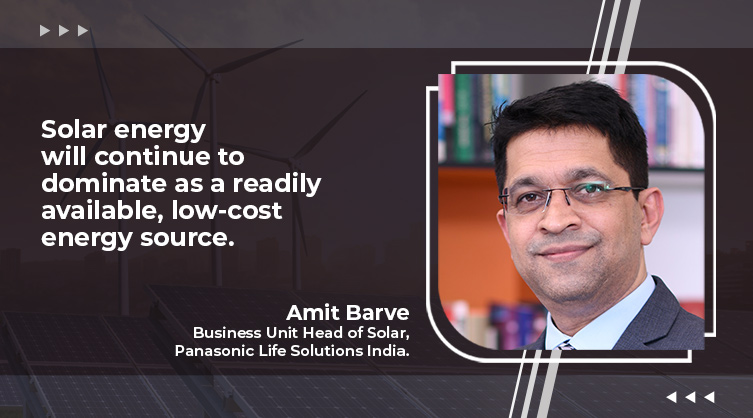We need to establish the value chain ecosystem for solar modules
By EPR Magazine Editorial March 24, 2023 3:07 pm
By EPR Magazine Editorial March 24, 2023 3:07 pm

Solar energy in India has reached grid parity, which adds certainty that it will remain an affordable energy source, says Amir Barve, BU Head for Solar at PLSIND.
What are the barriers to India reaching the goal of 300 GW of solar energy by 2030?
To achieve its declared objective of installing 300 GW of solar electricity by 2030, the Indian government has adopted different measures and is making admirable efforts in this sector. The creation of solar parks with plug-and-play infrastructure and PLI programs to jump-start raw materials in the solar value chain are all measures that assist in building a market. However, there are still certain obstacles that we should be aware of and take action to overcome.
Although PLI plans have been implemented to jump-start the industrial boom, we still rely significantly on imported manufacturing technology and equipment. Our acute lack of R&D across the whole value chain hinders our localisation efforts and increases our reliance on outside sources.
Distributed solar power is excellent for producing energy near where it will be used. The largest market for captive and collocated generation is residential rooftops, which has underperformed compared to expectations, which could jeopardise our stated objective. There is a need for widespread awareness raising, the facilitation of simple credit, and skilled local-level system installers who can aid in accelerating the growth of this market.
How are government policies and regulations contributing to our electricity generation and consumption self-sufficiency goal?
India has significantly contributed to green goals, increasing its installed solar capacity from 7 GW in 2016 to 64 GW in January 2023. Various factors, including government policies, incentivisation schemes, greater public awareness, and decreasing costs of solar power technology, have enabled this achievement.
Several regulatory triggers have helped drive this progress, including the declaration of a net-zero target by the Indian government at COP26 summits, the allocation of around ₹350 billion towards net-zero targets in the Union budget for 2023-24, and significant growth in the residential sector due to net-metering support and announcement of subsidies. Promoting indigenous production through the PLI program will also help reduce the risks associated with disruptions to the global supply chain by enabling the purchase of locally produced raw materials.
Moreover, the public sector has initiated support for the solar rooftop sector through banks and NBFCs’ loan disbursements. In addition, provisions incentivise common consumers to access green power at reasonable rates, including reducing the Open Access Transaction limit from 1 MW to 100 kW.

What challenges do Indian companies face while pushing and manufacturing products in India?
Even though India has a 25 GW capability for producing solar modules, the value chain ecosystem still needs to be sufficiently established. The production of efficient solar cells, necessary to create products that can compete, still needs to meet the required capacity requirements. However, there is still a lot of reliance on imported raw materials, which makes it costly and prone to delays, currency exchange fluctuations, and occasionally even quality.
The second largest problem for domestic producers is the severe need for more trained labour. We need more technical training facilities or educational institutions to produce enough trained labour to support this development in the face of rising manufacturing capacity. Industry expansion is being severely hampered by a skills gap and a lack of skilled labour, and immediate action will be needed to close this gap.
What technologies/initiatives are assisting us in developing indigenous, high-quality modules and cells?
The government has implemented several policy measures to promote the solar business and support the “Made in India” initiative. These include production-linked incentives to boost raw material manufacturers in India and market protection initiatives such as imposing basic customs duties on imported materials. These efforts, coupled with the solar industry’s growth, have instilled confidence in numerous businesspeople and Indian conglomerates to venture into the component manufacturing industry across the entire value chain. As a result, investments have been made to establish state-of-the-art manufacturing facilities that produce high-quality, modern solar products for Indian consumers.
How do you perceive the industry’s prospects for solar energy going forward?
Like any other nation, India has led the world in pushing and putting vast amounts of solar energy into use. Solar has reached grid parity in most of the world, including India, thanks to economies of scale. Solar energy will continue to be a popular energy source in the future due to the immediate availability of inexpensive power with significant environmental benefits. There is no turning back over the next two decades, and installed capacity in India and worldwide will continue to rise yearly.
For more details visit: https://lsin.panasonic.com/
We use cookies to personalize your experience. By continuing to visit this website you agree to our Terms & Conditions, Privacy Policy and Cookie Policy.